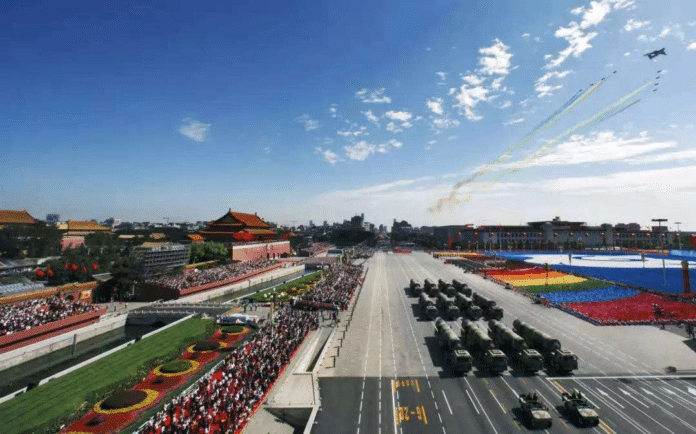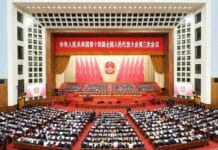New Cold War: Capitalist East and West are both in decline
Editorial, issue 75 of Socialist magazine (China magazine published by ISA in China, Hong Kong and Taiwan)
Socialist magazine and our international organisation ISA differ with the analysis of most other left organizations who see world imperialist rivalries as largely “multipolar’’, with the US in decline (yes, it is) and China rising (no, that is no longer true). A correct understanding of imperialism in our epoch and the disposition of forces between the imperialist powers is essential for a Marxist organisation, in order to correctly anticipate the general direction of world events and the challenges this presents for the workers’ movement.
Most of the left is lagging behind developments especially when it comes to China and its role. They, in most cases, do not even recognize the concept or use the term “New Cold War”, whereas even the main capitalist publications now use this term, long after we began to use it. Our analysis is outlined more fully in our book Chinese imperialism and the New Cold War, from chinaworker.info. Other left groups seem not to have noticed or fully grasped that China’s dictatorship and its authoritarian state capitalist economy is now in a life-and-death crisis. They still talk about China’s “rise” which is an outdated view. In the last two years the gap between the US and Chinese economies has widened. In 2021, China’s GDP was 75 percent of the US level. Last year it had declined to 65 percent. More and more economists now question whether China will overtake the US in economic terms. A recent study by Citi said this might not happen “until 2080”. While the CCP (so-called Communist Party) dictatorship reports inflated economic data, more so now than before, in reality China’s economy has barely grown at all for the last two years.
Two losers
Xi Jinping says, “the East is rising and the West is in decline”. This is wrong. Capitalism is in decline in both the East and the West. Our perspective for the imperialist Cold War is that both the Chinese and US-led capitalist blocs are in the throes of an extreme crisis: economic, social, political and ecological. Rather than one outright victor, it is more likely that the US-China conflict produces two losers. But this also depends on the working class and whether a serious Marxist force can be built on a world scale, at least initially in several of the most important imperialist countries.
At their summit in November last year, Xi Jinping and Joe Biden wanted to send a signal that the US-China conflict was stabilising. But in reality, both leaders are pursuing policies that further escalate their rivalry. This escalation encompasses all spheres: military, economic, technological and diplomatic.
Israel’s war on Gaza, with the US arming this horrific slaughter, has been a disaster for Biden’s government in political and ‘PR’ terms. This has cancelled out the propaganda advantages US imperialism gained through the Ukraine war, although its military and political gains as leader of the Western bloc remain. Chinese and Russian imperialism, while they are confined to making empty protests and incapable of offering any solution, exploit the Israeli-US crimes against the Palestinians, with over 31,000 killed and mass starvation a fact, to burnish their own image in the Middle East and the Global South. These are crucially important markets for China especially and serve as a diplomatic counterweight to US imperialism in organs like the UN. Public opinion in Arab countries and much of Africa has swung significantly against the US and towards China-Russia.
The Washington Institute, a think tank, reports: “The percentage of Arabs who believe America has a positive role in the war amounts only to 7%, with figures as low as 2% in countries like Jordan. By contrast, the percentage of Arabs who say that China has a positive role in the conflict included 46% in Egypt, 34% in Iraq, and 27% in Jordan.”
Unfortunately for Xi Jinping, this propaganda windfall cannot easily be translated into an increase in real power or economic control in the region or wider Global South. Trade protectionism is on the rise. As the US-led bloc progressively “decouples” from China it is forced to export its vast industrial surplus to its “friends” in the Global South, overwhelming economies that are less developed than China’s.
This reinforces a classical imperialist relationship as waves of Chinese manufactures squeeze out local producers, causing de-industrialization and even greater dependency on the export of energy, raw materials and farm products. Brazil, a fellow member of the China-dominated BRICS grouping, this year launched several anti-dumping investigations against Chinese products including steel and chemicals. Thailand and Vietnam are also threatening new measures against China’s exports.
Two major blocs
The world economy is now dominated by geopolitics. And geopolitics is dominated by the “bipolar” power struggle of the two strongest imperialisms: China and the US. The lesser imperialist powers are forced to adapt, check their own ambitions and “choose a side”. This trend has been clear for the past decade. But Russia’s invasion of Ukraine in 2022 was a turning point, which fast-forwarded the process towards two major imperialist blocs.
Following the invasion, the US was able to much more decisively dominate a revived Western bloc: the so-called “democracies”. This led to unprecedented militarization, largely at this stage accepted or not seriously challenged by the masses and the workers’ movement. This militarization trend includes NATO’s expansion into long-time “neutral” Nordic countries, more military alliances in Asia such as the recently launched ‘JAPHUS’ (Japan-Philippines-US), and an accelerated tech war against China under the guise of “national security”. The US-China imperialist conflict is not a temporary phase, but rather is likely to define the coming decades. This conflict is largely ‘cold’, but runs the danger of ‘hot’ outbreaks and especially proxy wars, as we have seen in Ukraine.
The era of supercharged neoliberal globalization, which characterized the decades from the 1980s until 2008, fostered the idea that national states were dying out – their power irreversibly checked and diminished by ‘free trade’, the power of transnational companies and neoliberal agreements. But capitalism can never fully develop the tendencies inherent within it. Nation states, created during the ascendancy of capitalism, cannot be overcome under capitalism. The process of accelerated capitalist globalization therefore hit a wall, reaching a tipping point during the worldwide crisis of 2008, after which “the state” has increasingly asserted itself as the dominant factor in global economy.
In particular this process sees the demonstration of power by the two biggest imperialist states, the US and China. The tech war, with microchips, AI and supercomputers as the key battlefields, is driven by economic but crucially also military considerations. US imperialism’s microchip sanctions against China, blocking its access to the most advanced chips and chip manufacturing equipment (from Japan and the Netherlands), is designed to cripple China’s ability to catch up and especially to stunt its military ambitions. The chip sanctions first imposed by Biden in October 2022 are a severe blow to China and Xi Jinping’s regime. We have since seen a second and third round of even tighter US sanctions.
China is ploughing huge amounts of state capital into its microchip sector to try to thwart the US tech war. Beijing may in some selective niche fields be able to score some victories in homegrown tech. But overall, the situation is not optimistic: China’s microchip story is about decades of wasted expenditure, large scale corruption and failure to progress beyond legacy levels. Zang Yi, a CPPCC delegate and head of the Shenzhen-based China Electronics Corporation, admitted during the recent Two Sessions that China’s tech companies still have a “long way” to go to catch up with the US, and warned “the gap is widening” in the AI field.
Stalinism and imperialism
There is a fundamental difference (actually several) between today’s Cold War and the former Cold War between the Stalinist USSR and the Western capitalist bloc led by the US. Stalinism meant the rule of a parasitic totalitarian bureaucracy over a state-owned planned economy. It was a monstrous caricature of “socialism”, but the proletarian base of its economic system meant it was not capitalism (despite considerable confusion among Maoists and Stalinists on this count) and therefore it was not imperialism.
By contrast, today’s aggressive power struggle is between two imperialist camps. This means it is potentially more unstable, intractable and dangerous than the old Cold War. Russian Stalinism increasingly sought accommodation with US imperialism from the 1960s onwards and played the role of a brake on the formation of new copycat Stalinist regimes globally. As imperialist powers, all today’s protagonists are driven towards conflict – to tear markets, resources and spheres of influence away from their opponents – in a way that was not posed when one of the blocs rested on non-capitalist foundations.
India vs. China
Nowhere is the new Cold War exacting greater economic changes and geopolitical realignments than in Asia, which is the decisive continent for global capitalism. Asia accounts for 40 percent of global GDP and 37 of the global labour force. India has shifted more closely into the US camp, as shown by its role in ‘the Quad’, a military alliance, and increased arms deals with the US. Above all, India’s stance is dictated by its fear of Chinese power encroaching on India’s imperialist interests especially within the South Asian sub-continent. Modi and the Indian ruling class are at the same time trying to position themselves as the “Next China”, to cash in on Western decoupling as factories and investments pull out of China. This includes a sizable number of Chinese capitalists who are shifting their production to India, Vietnam and Mexico, in order to get around US tariffs.
India disagrees with Washington over the Ukraine war, and refuses to criticize Russia, its traditional ally, or join the US-led sanctions. But Biden is prepared to look the other way in this case, because coaxing India into an economic and geostrategic alliance against China represents a much greater prize.
China’s strengthened influence in the Maldives is one of many disputes between the two Asian giants. Indian troops were ordered to leave the Maldives in March, after its new pro-China government signed a “military assistance” pact with Beijing. China has increased its sway over the governments in Bangladesh and Pakistan, which India now sees as “de facto satellites of China”.
China now runs three major ports in Chittagong (Bangladesh), Hambantota (Sri Lanka) and Gwadar (Pakistan) which some commentators have dubbed a “triangle of death” encircling India. In Sri Lanka, China has suffered serious setbacks due to its excessive ‘debt trap’ policies that created now abandoned white elephant projects. These became a symbol of popular anger in the mass struggle that forced the Sri Lankan president to flee the country in 2022.
India has been quick to exploit China’s difficulties, just as China has done at India’s expense in the Maldives. Last year, India clinched several energy and infrastructure deals with Sri Lanka, including an oil pipeline and energy grid linking the two countries.
That all the new Cold War allies do not move in tandem on all issues, does not negate the fact that the world imperialist conflict is being concentrated into two blocs. There are growing tensions in the Western bloc today over support for Ukraine in the proxy war against Russia. European governments are alarmed that a Trump victory could cut off US military support for Ukraine, resulting in a Russian victory. A complete cut off of US military “aid” is unlikely. But significantly, the argument of Trump and the far-right Republicans is that “Ukraine is the wrong war” – meaning the military spending should instead be used against China. Trump’s foreign policy agenda – if implemented – would dramatically escalate the trade war with China. He is threatening to increase tariffs against China from the current level of 25 percent to over 60 percent.
The bill passed in March in the Republican-controlled House of Representatives will ban TikTok within six months unless its owner, ByteDance, sells TikTok to a non-Chinese company. The TikTok case is a sign of things to come and shows the real direction of the US-China imperialist struggle – no “de-escalation”, rather the opposite. Biden has said he will sign the new TikTok bill if it is passed by the Senate. The difference between Biden and the Republicans over China policy is very small.
What about Trump?
The “Great Decoupling” between China and the US is already a clear trend. If re-elected Trump’s policies would put this process on steroids and could trigger a global depression. Last year, Mexico knocked China from its position as America’s number one trade partner. China is now in third place. If Trump wins, the tensions within the US-led bloc will grow. A more unstable and unpredictable period would likely begin. On the home front too, Trump could trigger mass upheavals with his ultra-right wing program leading to intensified attacks on workers, women, migrants and LGBTQ people.
Their common interest in standing up to the challenge from Chinese capitalism, will tend to hold the Western bloc together notwithstanding the destabilizing factor of Trump back in office. Likewise, the need to push back against the US is the cement that holds China’s bloc with Russia, Iran and others (North Korea, Pakistan) together.
There are tensions also in this bloc for example between Russia and China. The longer the Ukraine war continues the more Russia slips into an almost colonial dependence on China in economic terms. This is a humiliating state of affairs for the Russian ruling class. But would this lead them to break with China? Russia is a second-ranking imperialism. Its economy is only one-tenth the size of China’s, although it has a strong military and a huge nuclear arsenal. Who would the Kremlin be able to ally with if it broke away from China? Putin has no choice.
Similarly, China cannot decisively distance itself from Russia’s invasion of Ukraine, or support US sanctions. What would this achieve for Xi Jinping’s regime? Abandoning and isolating Russia over its war in Ukraine would in no way restore the Chinese regime’s relationship with US imperialism. The Western capitalist bloc would not moderate their economic and geostrategic pressure against China. The clock cannot be turned back.
Marxists today are operating amid decisive and irreversible changes in the structure of global capitalism, with the end of one era and start of a new one. Understanding what imperialism is, why it is today expressed through two fundamentally hostile blocs, is the first step in being able to develop clear perspectives and policies for rebuilding a fighting internationalist workers’ movement. The task is to end this system before it ends us.




